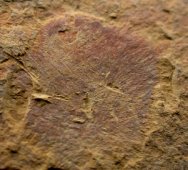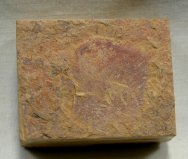| Name:
Porifera; Desmospongia: Choiaella radiata (Chengjiang Biota)
Age:
Early Cambrian (~525 million years ago)
Size (25.4mm=1
inch): 20 mm across on a 36 mm by 28 mm matrix
Fossil
Site: Chengjiang - Quiongzhusi Section, Yu’anshan Member, Heilinpu
Formation Kunming, Anning, Yunnan Province, China
|  Description:
This is a rarely seen member of the Desmospongia, the most diverse
of modern-day sponges. Greater than 90% of the extant 5,000 known
species of sponges are desmosponges. Such a representation in the
fossil record is not maintained where less than half the known genera
are of this type, a consequence of the fact that the skeletons do
not fossilize readily. Desmosponge skeletons are composed of spongin
fibers and/or siliceous spicules. Sponges are known from the late
Precambrian, with few localities contributing to the fossil record
over time. The Chengjiang Biota is one such fossil lagerstatte.
The diversity of soft-tissue fossils is astonishing: algae, medusiforms,
sponges, priapulids, annelid-like worms, echinoderms, arthropods
(including trilobites), hemichordates, chordates, and the first
agnathan fish make up just a small fraction of the total. Numerous
problematic forms are known as well, some of which may have represented
failed attempts at diversity that did not persist to the present
day. Choiaella radiata, a rare sponge that is discoidal to shield-shaped,
with the spicules arrayed radially as seen here, is envisioned as
a tuft-like to brush-like sponge that emanates from a central point.
Comparison with the Recent sponge Radiella suggests that both sponges
shared a similar infaunal lifestyle. Description:
This is a rarely seen member of the Desmospongia, the most diverse
of modern-day sponges. Greater than 90% of the extant 5,000 known
species of sponges are desmosponges. Such a representation in the
fossil record is not maintained where less than half the known genera
are of this type, a consequence of the fact that the skeletons do
not fossilize readily. Desmosponge skeletons are composed of spongin
fibers and/or siliceous spicules. Sponges are known from the late
Precambrian, with few localities contributing to the fossil record
over time. The Chengjiang Biota is one such fossil lagerstatte.
The diversity of soft-tissue fossils is astonishing: algae, medusiforms,
sponges, priapulids, annelid-like worms, echinoderms, arthropods
(including trilobites), hemichordates, chordates, and the first
agnathan fish make up just a small fraction of the total. Numerous
problematic forms are known as well, some of which may have represented
failed attempts at diversity that did not persist to the present
day. Choiaella radiata, a rare sponge that is discoidal to shield-shaped,
with the spicules arrayed radially as seen here, is envisioned as
a tuft-like to brush-like sponge that emanates from a central point.
Comparison with the Recent sponge Radiella suggests that both sponges
shared a similar infaunal lifestyle.
|
|

